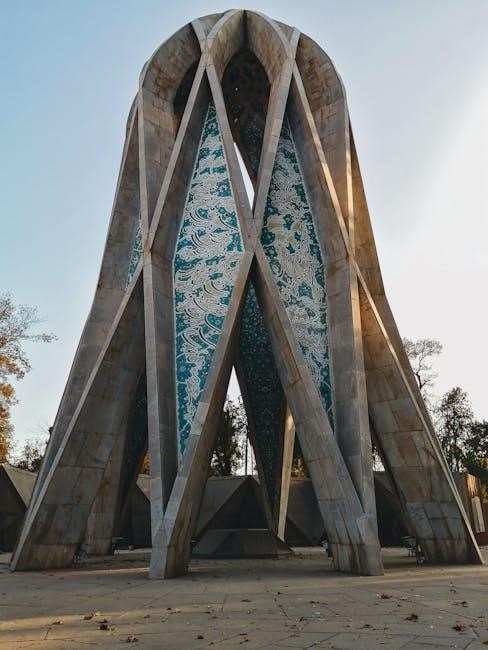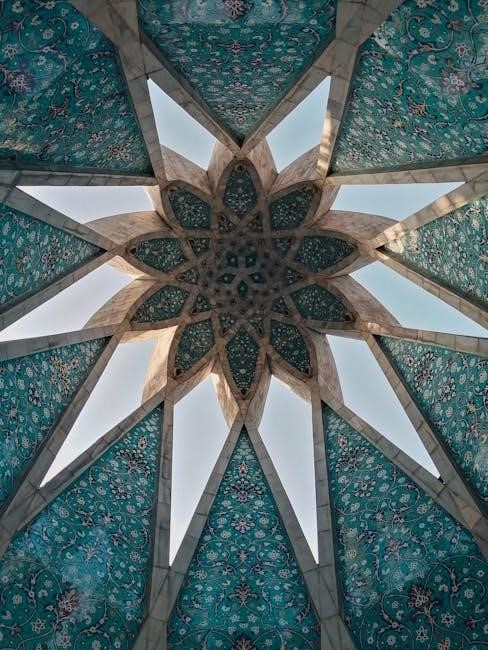
omar khayyam rubaiyat pdf
Omar Khayyam, a Persian polymath, is renowned for his poetry and philosophical insights, particularly in the Rubaiyat, a collection of quatrains exploring life, fate, and Existence.
This timeless work, translated by Edward Fitzgerald, has captivated readers globally with its profound themes and poetic beauty, now widely accessible in PDF formats.
1.1 Who Was Omar Khayyam?
Omar Khayyam, born in 1048 in Nishapur, Persia, was a polymath excelling as an astronomer, mathematician, philosopher, and poet. His contributions to algebra and astronomy were seminal, influencing Islamic Golden Age scholarship and beyond. Khayyam’s poetry, particularly the Rubaiyat, reflects his philosophical views on life, fate, and existence, blending deep contemplation with literary elegance. His works transcend cultural boundaries, appealing to both Eastern and Western audiences. Though his exact role in creating all the quatrains attributed to him is debated, his legacy endures as a thinker whose verses resonate universally, exploring themes of impermanence, love, and the human condition.
1.2 The Significance of the Rubaiyat
The Rubaiyat holds immense cultural and literary significance as a collection of Omar Khayyam’s quatrains, offering profound reflections on life, fate, and human existence. Its poetic and philosophical depth has made it a timeless classic, resonating across cultures and centuries. The work’s themes of impermanence, love, and existential inquiry have captivated readers worldwide, transcending linguistic and cultural barriers. Edward Fitzgerald’s translation further amplified its global appeal, introducing Khayyam’s wisdom to Western audiences. The Rubaiyat’s enduring relevance lies in its universal themes, making it a cherished work in both Eastern and Western literary traditions, and its availability in PDF formats has ensured its accessibility to modern readers.
1.3 Overview of the Rubaiyat PDF
The Rubaiyat PDF offers a comprehensive digital edition of Omar Khayyam’s timeless poetry, featuring his iconic quatrains alongside complementary works like Salámán and Absál. This special edition, presented by DigiCat Publishing, includes both the original Persian texts and their English translations, providing readers with a rich, bilingual experience. Enhanced with contributions such as a biography of Edward Fitzgerald and an essay on Persian poetry by Ralph Waldo Emerson, this PDF is a valuable resource for scholars and enthusiasts alike. The digital format ensures accessibility, allowing modern readers to explore Khayyam’s profound reflections on life and existence with ease. This edition is a testament to the enduring legacy of the Rubaiyat, now available in a convenient and portable format.

Historical Background of the Rubaiyat
The Rubaiyat reflects Omar Khayyam’s life as a 11th-century Persian poet, astronomer, and philosopher, whose works were later popularized in the West by Edward Fitzgerald’s translations.
Khayyam’s poetry, blending philosophical depth with poetic beauty, resonated deeply across cultures, making the Rubaiyat a timeless literary treasure, now widely accessible in digital formats.
2.1 The Life and Times of Omar Khayyam
Omar Khayyam, born in the 11th century in Persia (modern-day Iran), was a polymath excelling as a poet, mathematician, astronomer, and philosopher.
His rationalistic views and philosophical poetry often sparked controversy, yet his intellectual contributions remain unparalleled.
Living during a time of cultural and scientific flourishing, Khayyam’s work reflected both the wisdom of Persian tradition and the curiosity of a scholar.
His poetry, particularly the Rubaiyat, captures themes of existential inquiry and the fleeting nature of life;
Despite his fame, Khayyam’s personal life remains somewhat enigmatic, adding to the mystique surrounding his legacy.
Edward Fitzgerald’s translation later introduced Khayyam’s work to the West, cementing his global influence.
2.2 The Structure and Content of the Rubaiyat
The Rubaiyat is a collection of quatrains, or four-line poems, that explore themes of life, death, love, and existential inquiry.
Each quatrain is a self-contained epigram, often reflecting Khayyam’s philosophical musings and his unique blend of rationalism and mysticism.
The poems are structured in a specific rhyming scheme, adding to their lyrical and reflective nature.
Edward Fitzgerald’s translation popularized the work, capturing its essence while adapting it to Western literary sensibilities.
The content delves into universal themes, making the Rubaiyat a timeless work that transcends cultural boundaries.
Its blend of poetry and philosophy continues to resonate with readers, offering insights into the human condition and the fleeting nature of existence.
The Embassy of Iran’s translation and calligrapher Abbas Akhavein’s work further highlight its enduring appeal and cultural significance.
2.3 The Transmission of the Rubaiyat to the West
The Rubaiyat gained prominence in the West through Edward Fitzgerald’s translation, which introduced Omar Khayyam’s poetry to European audiences.
Fitzgerald’s rendition, while not a literal translation, captured the essence of Khayyam’s quatrains, blending their philosophical depth with poetic beauty.
The transmission was further aided by growing interest in Persian literature during the 19th century, with scholars like John Ruskin praising Fitzgerald’s work.
The Embassy of Iran later supported translations, ensuring the Rubaiyat’s cultural authenticity was preserved while reaching global readers.
Calligrapher Abbas Akhavein’s contributions and Mazaher Mosaffa’s compilations highlight the collaboration between Eastern scholars and Western translators.
Today, the Rubaiyat is widely accessible in PDF formats, making its timeless wisdom available to a modern audience.
This transmission has bridged cultural gaps, showcasing the universal appeal of Khayyam’s poetry and philosophy.

The Role of Edward Fitzgerald in Popularizing the Rubaiyat
Edward Fitzgerald’s poetic translation of the Rubaiyat introduced Omar Khayyam’s work to the West, blending scholarly accuracy with artistic flair, making it globally renowned.
3.1 Who Was Edward Fitzgerald?
Edward Fitzgerald was a 19th-century British poet and translator, best known for his poetic adaptation of Omar Khayyam’s Rubaiyat. Born in 1809, Fitzgerald was a scholar of classical and Persian literatures, with a deep appreciation for the works of Khayyam. His translation, first published in 1859, was not a literal translation but a creative interpretation that captured the essence and philosophical depth of Khayyam’s quatrains. Fitzgerald’s work was instrumental in introducing Persian poetry to the Victorian era, sparking widespread interest in Eastern literature. His translation was praised for its lyrical beauty and accessibility, making it a beloved classic in English literature. Fitzgerald’s adaptation of the Rubaiyat remains a testament to his literary skill and cultural bridging.
3.2 Fitzgerald’s Translation and Its Impact
Edward Fitzgerald’s translation of the Rubaiyat was a groundbreaking work that introduced Omar Khayyam’s poetry to the Western world. His adaptation, while not strictly literal, captured the essence of Khayyam’s verses, blending philosophical introspection with poetic beauty. The translation’s success lay in its ability to resonate with Victorian-era readers, offering themes of existential reflection, hedonism, and the fleeting nature of life. It sparked widespread interest in Persian literature and influenced later writers and artists. Fitzgerald’s work not only popularized the Rubaiyat but also laid the foundation for its enduring legacy, making it a cultural bridge between East and West. Its impact remains evident in literature and art to this day, ensuring Khayyam’s relevance across centuries.
3.3 The Reception of Fitzgerald’s Translation
Edward Fitzgerald’s translation of the Rubaiyat received widespread acclaim upon its publication in 1859. It quickly became a cultural phenomenon, captivating readers with its lyrical prose and profound philosophical themes. The Victorian public embraced its blend of hedonism and melancholy, finding resonance in its exploration of life’s transient nature. However, scholars criticized Fitzgerald’s liberal approach, arguing that it deviated from the original Persian text; Despite this, the translation’s impact was undeniable, sparking a wave of interest in Persian literature and cementing Omar Khayyam’s place in Western cultural consciousness. Its enduring popularity highlights the power of Fitzgerald’s interpretation to transcend linguistic and cultural boundaries.

The Rubaiyat in PDF Format
The Rubaiyat PDF offers an elegantly designed, easily accessible version of Omar Khayyam’s iconic verses, ensuring enhanced readability and preserving the poetic essence for modern readers.
4.1 Features of the Rubaiyat PDF
The Rubaiyat PDF is a meticulously crafted digital version of Omar Khayyam’s timeless poetry, offering a seamless reading experience.
- High-resolution text and illustrations ensure clarity and visual appeal.
- Interactive features like bookmarks and search functionality enhance navigation.
- The PDF retains the poetic meter and rhyme scheme, preserving the original’s lyrical essence.
- Annotations and introductions provide historical and cultural context.
- Compatibility with various devices allows readers to access it on smartphones, tablets, and computers.
These features make the Rubaiyat PDF a valuable resource for both scholars and casual readers.
4.2 Availability and Accessibility of the PDF
The Rubaiyat PDF is widely available due to its public domain status, ensuring easy access for readers worldwide.
- It can be downloaded from various online platforms like Google Books, Project Gutenberg, and university repositories.
- Many websites offer free downloads, making it accessible to anyone with an internet connection.
- The PDF format ensures compatibility with multiple devices, including smartphones, tablets, and e-readers.
- Its digital nature allows for easy sharing and distribution across different platforms.
This accessibility has contributed to the enduring popularity of Omar Khayyam’s work in the modern era.

4.3 The Advantage of Digital Versions

Digital versions of the Rubaiyat offer numerous advantages, enhancing accessibility and readability for modern audiences.
- Portability is a significant benefit, as digital files can be stored on various devices, allowing readers to carry the text anywhere.
- Digital versions often include features like search functions, adjustable font sizes, and night modes, improving the reading experience.
- They are typically more affordable or even free, making the Rubaiyat accessible to a broader audience.
- Digital formats reduce the need for physical storage, appealing to those who prefer minimalistic or environmentally conscious options.
- Additional resources, such as annotations or commentaries, can be easily integrated into digital editions.
Overall, digital versions of the Rubaiyat PDF ensure that Omar Khayyam’s timeless poetry remains accessible and engaging in the modern world.

Linguistic and Cultural Significance
Omar Khayyam’s Rubaiyat holds profound linguistic and cultural significance, blending Persian heritage with universal philosophical themes, making it a timeless bridge between East and West.
5.1 The Poetry and Philosophy of Omar Khayyam
Omar Khayyam’s poetry, as reflected in the Rubaiyat, embodies a unique blend of philosophical introspection and poetic beauty. His verses explore themes of existentialism, fate, and the human condition, often questioning divine purpose. Khayyam’s philosophy, though rooted in Sufi mysticism, embraces a hedonistic worldview, encouraging individuals to cherish life’s fleeting pleasures. His use of simple yet profound language creates a universal appeal, transcending cultural boundaries. The Rubaiyat’s quatrains are filled with natural imagery, such as wine, gardens, and the moon, symbolizing life’s transient nature. Khayyam’s work challenges readers to reflect on existence, making his poetry both a literary masterpiece and a philosophical guide.
5.2 The Influence of Persian Culture on the Rubaiyat
The Rubaiyat is deeply rooted in Persian culture, reflecting its rich literary and philosophical traditions. Omar Khayyam’s work is infused with Sufi mysticism, a central aspect of Persian spirituality, which emphasizes introspection and divine love. The use of Persian language and its lyrical cadence adds a unique charm to the quatrains. Themes of love, nature, and existential contemplation resonate with Persian cultural values. The imagery of gardens, wine, and moonlight evokes the Persian aesthetic of beauty and fleeting joy. Khayyam’s poetry also mirrors Persian wisdom, blending intellectual depth with emotional resonance. This cultural essence makes the Rubaiyat a timeless representation of Persian identity and universal human experiences, preserved in its digital forms like the Rubaiyat PDF.
5.3 The Universal Themes in the Rubaiyat
Omar Khayyam’s Rubaiyat explores universal themes that transcend time and culture, making it a timeless literary treasure. Central to the quatrains are reflections on existence, fate, and the human condition, which resonate deeply with readers globally. Themes of love, mortality, and the fleeting nature of life are woven throughout the poetry, inviting introspection and philosophical contemplation. The Rubaiyat also delves into the paradoxes of destiny and free will, questioning the mysteries of the universe. Its exploration of joy, sorrow, and the pursuit of meaning speaks to fundamental human experiences. These universal themes, combined with their poetic elegance, have made the Rubaiyat a cherished work across diverse cultures and eras, ensuring its enduring relevance in both physical and digital formats like the Rubaiyat PDF.

The Rubaiyat in Modern Context
The Rubaiyat remains relevant in today’s digital age, with its themes of existential reflection and philosophical inquiry resonating across modern media and cultural discourse.

6.1 The Relevance of the Rubaiyat Today
The Rubaiyat remains profoundly relevant in contemporary times, offering timeless reflections on life, love, and existential inquiry. Its exploration of universal human experiences transcends cultural and temporal boundaries.
6.2 Modern Interpretations and Adaptations
The Rubaiyat has inspired countless modern interpretations, from literary reimaginations to artistic adaptations. Contemporary writers and poets often draw on its philosophical themes, blending them with modern narratives. Filmmakers, musicians, and stage producers have also adapted its verses, creating works that resonate with today’s audiences. Digital formats, such as the Rubaiyat PDF, have further democratized access, allowing new generations to engage with Khayyam’s wisdom. Graphic novels and multimedia presentations now bring the Rubaiyat to life, merging traditional poetry with modern visual storytelling. These adaptations ensure that Omar Khayyam’s timeless insights remain relevant, connecting past and present in innovative ways.
6.3 The Legacy of Omar Khayyam in Contemporary Literature
Omar Khayyam’s legacy endures as a cornerstone of world literature, influencing contemporary writers and thinkers. His exploration of existential themes, love, and the human condition continues to resonate, inspiring modern authors to explore similar ideas. The Rubaiyat’s philosophical depth has shaped works across genres, from poetry to prose, encouraging reflections on life’s mysteries. Digital versions, like the Rubaiyat PDF, have made his work accessible to a global audience, fostering new interpretations. Many contemporary writers draw on Khayyam’s skepticism and hedonism, blending them with modern perspectives. His legacy is evident in the way his verses provoke thought and creativity, ensuring his relevance in today’s literary landscape.

How to Access the Rubaiyat PDF
The Rubaiyat PDF is easily accessible through various online platforms, including academic websites, digital libraries, and e-book repositories. Simply search for “Omar Khayyam Rubaiyat PDF” to find reliable sources.
7.1 Sources for Downloading the Rubaiyat PDF
The Rubaiyat PDF can be downloaded from various reliable sources online. Popular platforms like Google Books, Project Gutenberg, and Internet Archive offer free access to the text. Additionally, many university websites and digital libraries provide downloadable versions. Websites such as ManyBooks and HathiTrust also host the Rubaiyat in PDF format. For a more modern experience, platforms like Google Play Books and Amazon Kindle offer downloadable versions, often for free or at a low cost. Always ensure the source is reputable to avoid downloading low-quality or unauthorized copies. These platforms make it easy to access and enjoy Omar Khayyam’s timeless poetry in a convenient digital format.
7.2 Tips for Reading and Understanding the PDF
Reading the Rubaiyat PDF requires a thoughtful approach to fully grasp its depth. Start by familiarizing yourself with the introduction or preface, as it often provides historical and philosophical context. Pay attention to the structure, as the quatrains are meant to be contemplative and open to interpretation. Take notes on verses that resonate with you, and reflect on their meanings. Use online resources or study guides to understand complex metaphors and references. Joining a book club or discussion group can also enhance your understanding. Read aloud to appreciate the lyrical quality of the poetry. Finally, be patient and allow the themes to sink in, as the Rubaiyat is a work meant to be savored and revisited.
7.3 Legal and Ethical Considerations forDownloading
7;3 Legal and Ethical Considerations for Downloading
When downloading the Rubaiyat PDF, ensure you adhere to legal and ethical standards. Verify the source to avoid pirated or unauthorized versions, as this supports creators and respects copyright laws. Many classic works, including Omar Khayyam’s poetry, are in the public domain, but specific translations may be copyrighted. Always opt for reputable websites or platforms that offer free, legal downloads. Additionally, consider purchasing physical copies or digital versions from authorized sellers to support the preservation of literary works. By doing so, you contribute to maintaining the integrity and availability of such timeless literature for future generations.